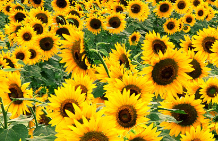Scientists with the Agricultural Research Service have shown that seed meal from plants in the mustard family can kill mosquito larvae, which start their lives in stagnant water before emerging into winged adults that take to the air in search of a blood meal.
The findings, recently published in the journal Scientific Reports, open the door to a biobased approach to controlling the biting insect pests. Adult female mosquitoes feed on the blood of people and other animal hosts to produce eggs. But more than just an itchy nuisance, the pest’s bite can also transmit debilitating diseases.
At the ARS National Center for Agricultural Utilization Research in Peoria, Illinois, a team of scientists has set their sights on the discovery and development of environmentally friendly approaches for controlling mosquitoes at the habitat level and for individual consumer applications.
On a habitat basis, they’re focusing on products derived from plants and other natural sources that may offer an ecologically friendly way to target mosquito larvae, the pest’s most vulnerable life stage.
Some consumers may be hesitant to apply synthetic insecticide products, so alternative compounds that naturally repel or kill mosquitoes are also being examined. This research push also addresses another concern: preventing the onset of mosquito resistance to synthetic insecticide ingredients, noted Lina Flor-Weiler, an entomologist with the ARS center’s Crop Bio-protection Research Unit.
Together with ARS co-authors Robert Behle, Mark Berhow, Susan McCormick, Steven Vaughn, Ephantus Muturi and William Hay, Weiler is the first to report the potential of mustard seed meal to kill mosquito larvae, which feed on bits of organic matter and microorganisms in shallow bodies of water such as ponds, swamps, kiddie pools, old tires, tree hollows and other aqueous sites.
As larvae, the pests are largely confined to a concentrated area after hatching from eggs deposited there by adult female mosquitoes—a scenario that makes for an ideal pre-emptive strike against the pests before they can mature, mate and bite people, birds and other animals to start the whole miserable cycle over again. Sometimes, the environmental sensitivity of these areas or the presence of non-target organisms warrant a non-chemical solution to control mosquito larvae, such as with formulations that inhibit their growth, suffocate them or infect them with specialized bacteria.
In studies begun in 2022, the researchers examined the larval-killing potential of isothiocyanates, a group of plant defense chemicals that are released when mustard seed meals are soaked in water. “The mustard plant stores inactive defense compounds (glucosinolates) in the seed that can be converted into biologically active isothiocyanates by enzymes called myrosinases,” explained Hay, an ARS plant physiologist. Prior research by other groups has shown that isothiocyanates can kill insect pests and soilborne parasites and pathogens, including root-damaging nematodes and disease-causing fungi, he added.
However, there was little in the existing scientific literature about the potency of these compounds against medically important insect disease vectors like mosquitoes, noted Weiler.
To learn more, the researchers prepared seed meal from four types of mustard family plants (brown mustard, pennycress, garden cress and white mustard) and added varying concentrations of them to small beakers of water containing larvae of Aedes aegypti mosquitoes, which can also transmit dengue, yellow fever, Zika and other diseases. The researchers also exposed larvae in separate beakers to one of three types of isothiocyanates extracted from the meals. In all trials, they monitored the effects on the larvae at 24 and 72 hours and documented the highest isothiocyanate concentrations needed to kill at least 50 percent of the immature insects.
Of the four seed meal types, garden cress proved the most lethal, killing more than 95% of mosquito larvae after only 24 hours and 100% in less than 48 hours. All seed meals were toxic to the larvae, except for a pennycress treatment that had been heated. This was intentionally done to deactivate myrosinase enzymes (which are necessary for the production of isothiocyanate) and confirm that their absence in the seed meal allowed the larvae to survive.
More studies are planned, the researchers said, but the early evidence thus far points to a promising bio-based alternative to synthetic insecticides that can be derived from an inexpensive agricultural byproduct of processing mustard seed into oil and spices.
As reported in the High Plains Journal.




